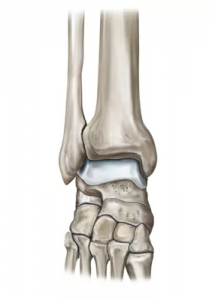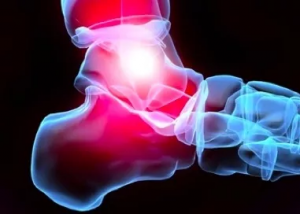
The ankle joint
Ankle arthritis refers to damage to the smooth cartilage which normally lines the ankle joint. This can be caused by wear and tear, as a result of a previous injury, or can come on for no obvious reason. It sometimes runs in families. It typically affects people in their 60s and 70s, but not uncommonly affects younger adults, particularly those involved in a lot of contact sports. When the cartilage wears down to bare bone the condition becomes serious.
The ankle is made up of the tibia (shinbone), fibula, and talus. On a simplistic level the ankle works as a sort of hinge, but the actual biomechanics are rather more complicated. It has very specialised cartilage which takes an enormous amount of force in day to day activities.
When ankle arthritis develops you will experience stiffness in the ankle with a loss of ability to bend the foot fully upwards. It may be painful in this position, and may become painful as you take strides, and the ankle is forced in to this position as your body moves forwards over your foot. To start with this is worse with activities, typically walking. You may also notice swelling in the ankle. Squatting down may become difficult. The pain is typically a dull aching pain somewhat like a tooth ache. In the early stages it will respond well to anti-inflammatories or painkillers, but as the condition progresses these become less effective.
In the early stages of arthritis painkillers, physiotherapy, and ankle braces can be helpful. As the condition progresses injections of steroid or replacement joint fluid (Durolane) can be useful. Keyhole (arthroscopy) surgery can be very effective for early arthritis to to remove bone spurs at the front of the ankle (an operation called chielectomy).
The ankle seems to tolerate more wear than other joints before it becomes really bad. However with time the arthritis may affect your mobility, and you’re walking distances. It will impact on your lifestyle, and impair quality of life. It may become painful at night-time and keep you awake at night or wake you up from sleep. When the symptoms reach this level it is time to consider having surgery.

There is an important choice to make between having the joint fused (arthrodesis), which means there will be no movement in the ankle itself, and no pain, or an ankle replacement. Unfortunately the ankle replacement technology is a long way behind that of hip and knee replacements, an the lifespan of these joints is not as good. For that reason ankle fusion remains a popular choice especially for younger patients in whom ankle replacement may only last a few years before causing problems. Ankle fusion is not a bad as it sounds, the remaining joints in the back of the foot compensate for the loss of motion at the ankle an allow relatively normal movements. Usually by the time this surgery is considered there is very little motion in the ankle joint anyway because of the arthritis. Many people with an ankle fusion return to their previous sports.
